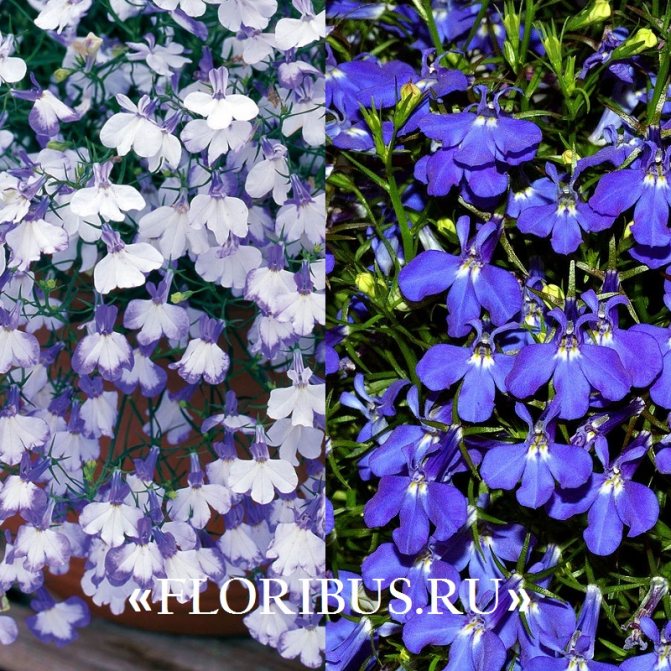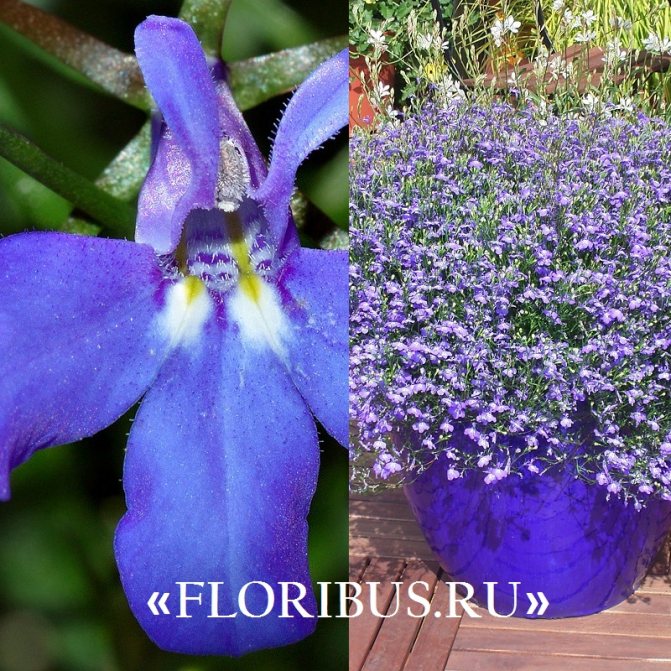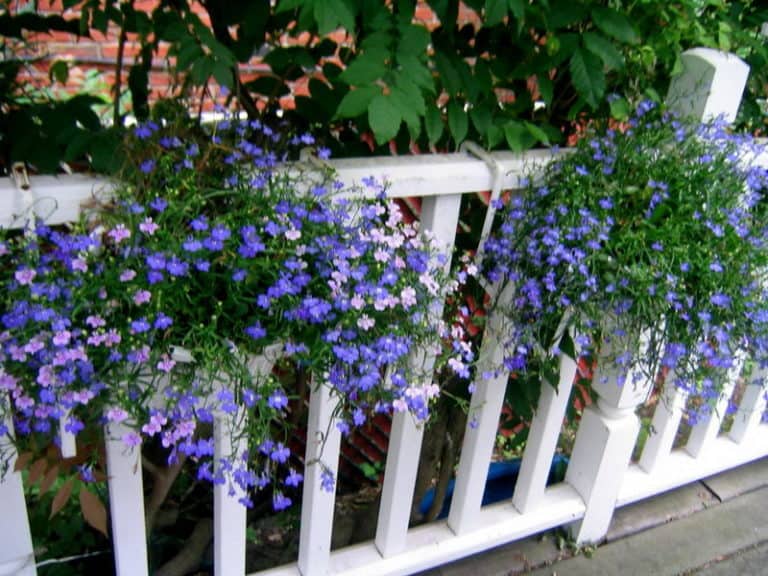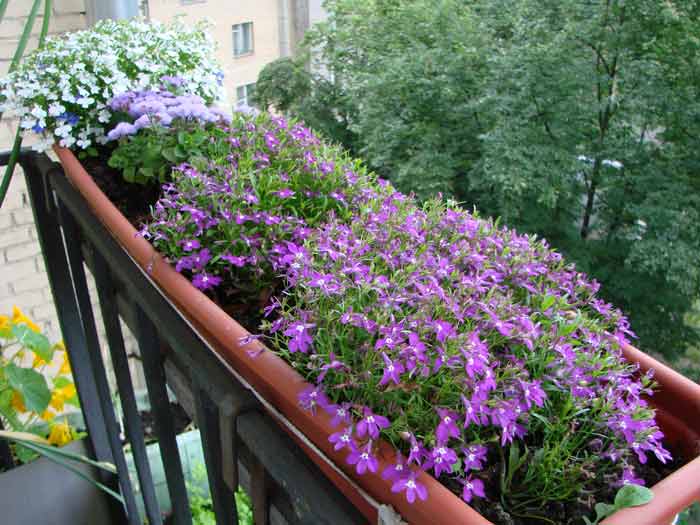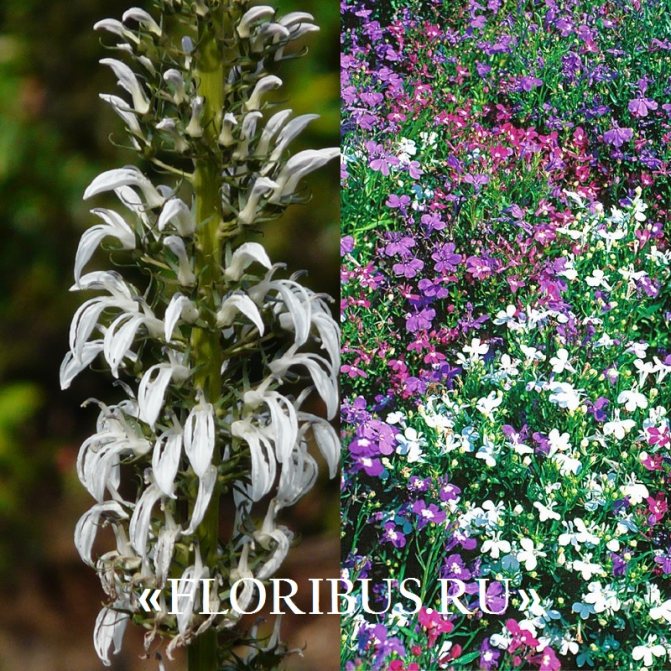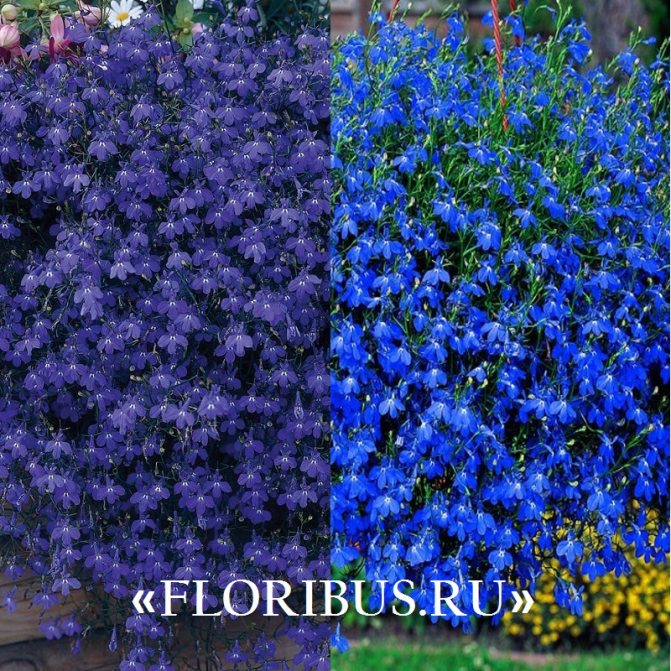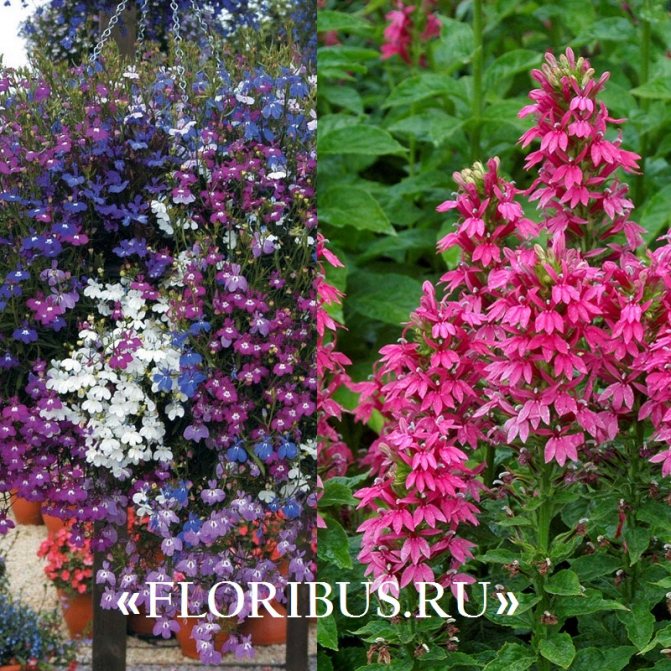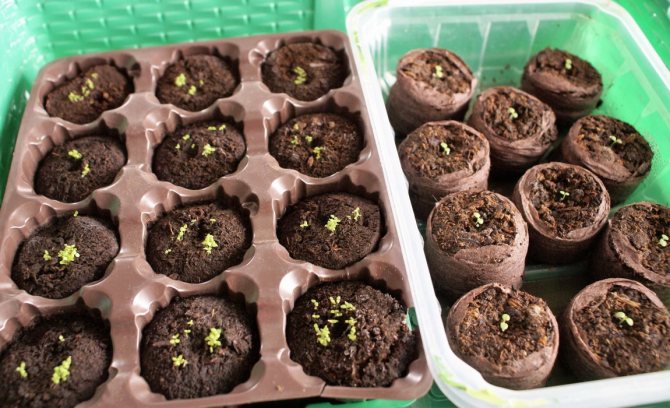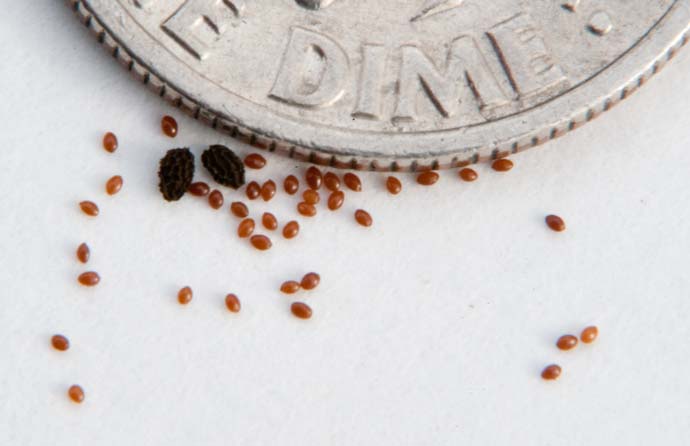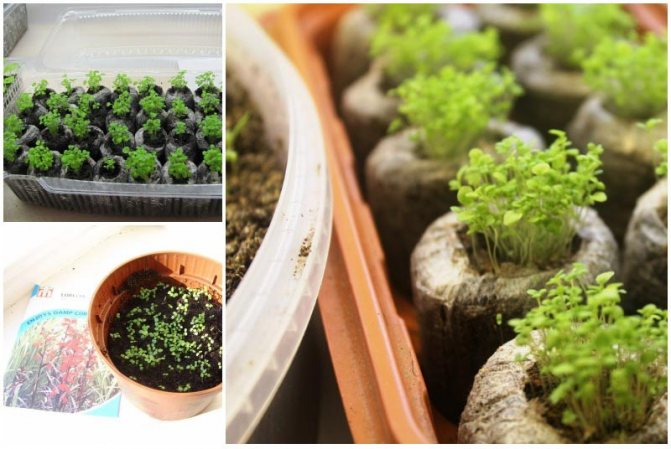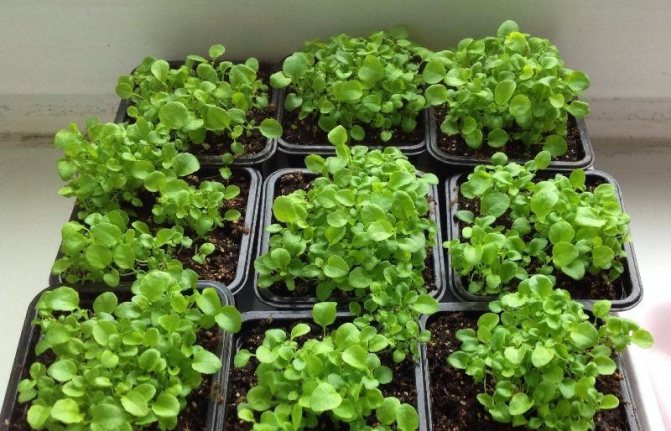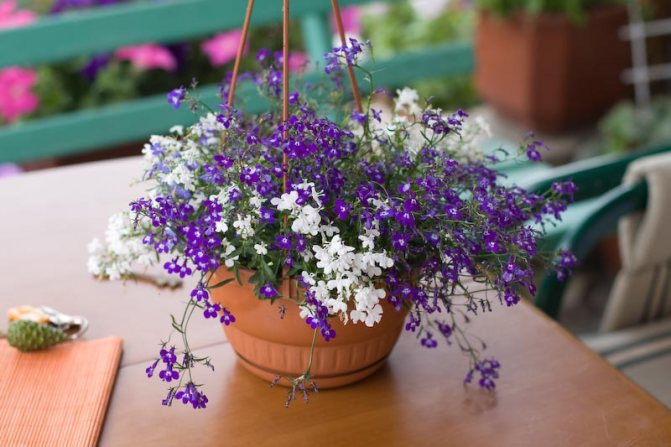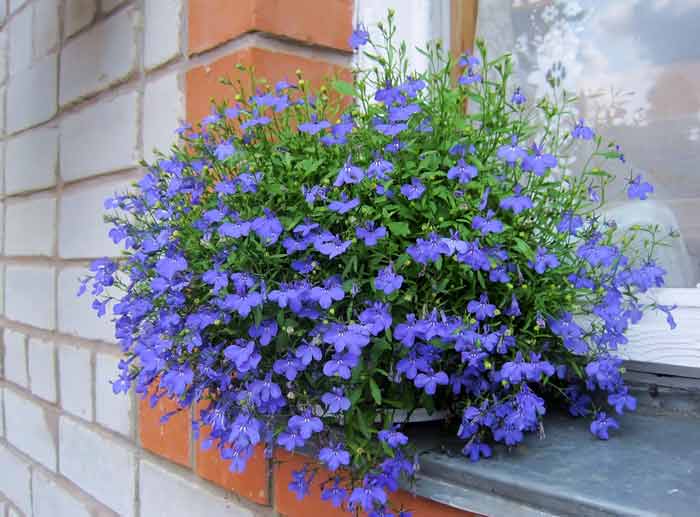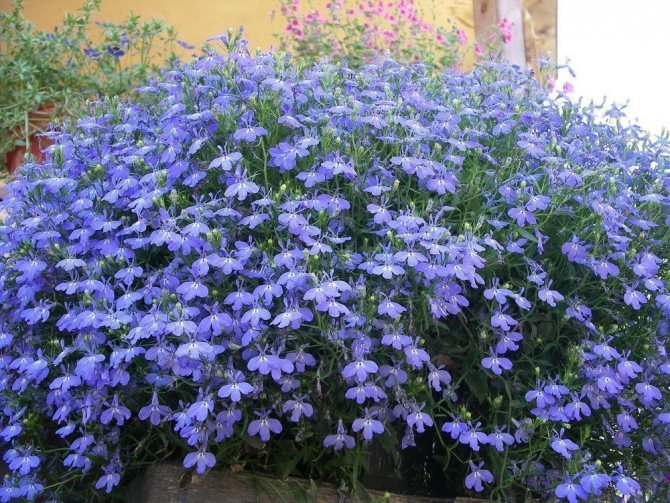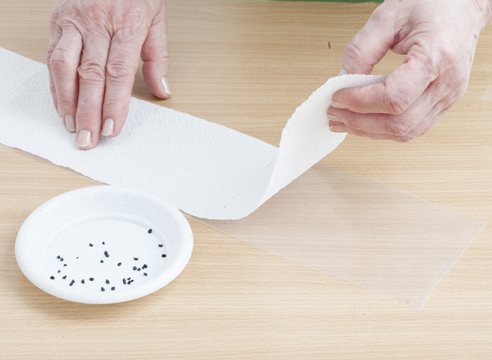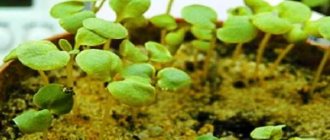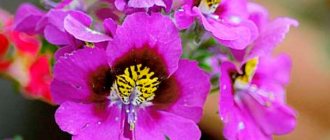Lobelia types, description
In total, there are up to 300 types of lobelia in the world. There are annual and perennial varieties, as well as ampelous, dwarf, spreading, erect and compact flower species.
Trailing or climbing
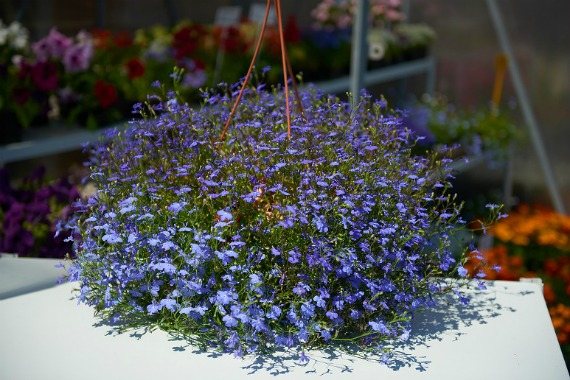
This type of lobelia has delicate and thin stems on which small, oblong leaves grow.
They are located quite densely. When the stems grow up to 10-15 cm, they begin to slope, and in this form they continue to grow, they can reach up to 50 cm in length.
The flowers of this type of lobelia are quite small (up to 1.5-2 cm in diameter), have an irregular shape, and are located along the entire length of the stem.
The palette of shades of ampelous lobelia is quite wide.
- Most often, you can find blue and blue colors.
- But there are also white, pink, crimson and lilac.
Erect
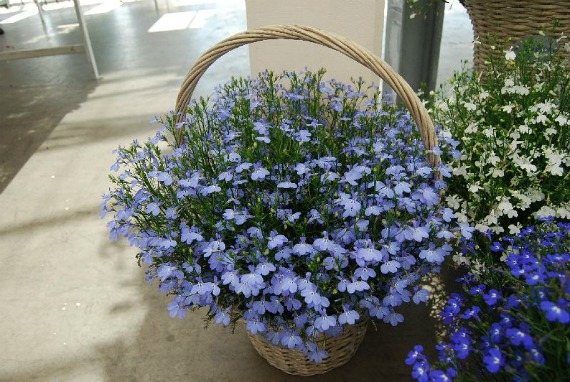

Lobelia erect has high, strong stems that grow upward all the time. It grows up to 25 cm. The leaves are small, dense, green. Flowers grow up to 3 cm in diameter.
Differs in a variety of colors with a large white spot in the center.
Compact


It differs from other species in straight, not creeping stems, which grow no more than 15-20 cm in height.
Dwarf


This species is distinguished by the smallest plants. The height of the bushes is no more than 8-12 centimeters. The short stature of the plant does not in any way affect the duration and abundance of flowering.
Varieties: description of appearance and photo
Ampel lobelias are so fond of flower lovers that you can find on sale not only natural species, but also artificially bred ones.
"Marquis"
The ampelous lobelia of the Marquis variety is a typical representative of the breeding species. In nature, you will not find such a color of flowers, in this species they have a red-terracotta shade. An elegant plant, the shape of the bush is cascading, the shoots are abundantly covered with flowers and tend to hang from the pot. The height of the stems is up to 50 centimeters. The flowering is very rich and occurs throughout the warm season.
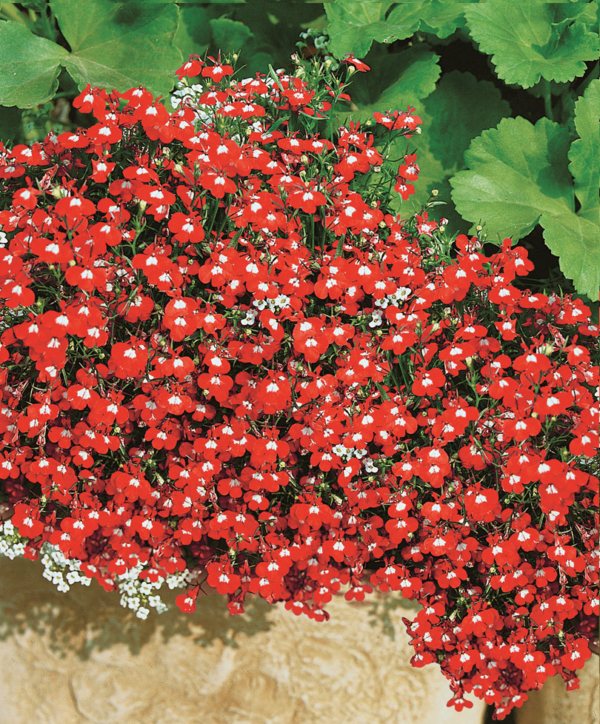

Niagara
The length of the shoots of this variety reaches 45-50 centimeters. The bush is dense and branches from the base. It blooms from June until the first frost. Flowers are distinguished by rich purple and deep blue color.
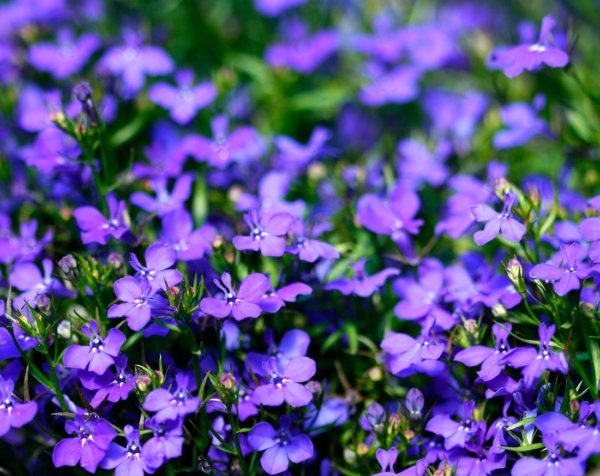

"Blue cascade"
It bushes well, blooms profusely throughout the season. The size of the flowers does not exceed two centimeters, they stand out with a bright blue color. Flowers from June to September, in the southern regions - until October-November.
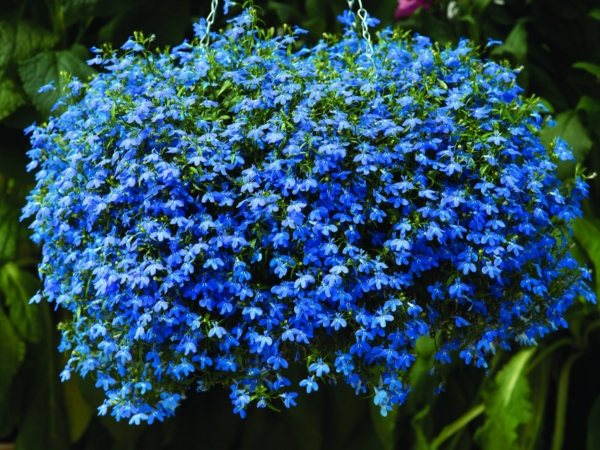

"Blue sky regatta"
This variety belongs to the early ones, since it begins to bloom earlier than others by 3 or 4 weeks. The bush is stunted, the stem length does not exceed 20 centimeters. Blooms generously all summer. The diameter of the inflorescences is not more than 1.5 centimeters, shades of color vary from pale blue with a tint of violet to blue and light blue.


"Sapphire" (or "Blue Cloud")
The flowers are pale blue with white blotches in the center. The length of the shoots is up to 30 centimeters, the bush is compact, grows quickly and is unpretentious. The circumference of the bush reaches 1.5 meters, which allows you to successfully use it in the design of alpine slides.
We talked more about the motley sapphire lobelia in this article.
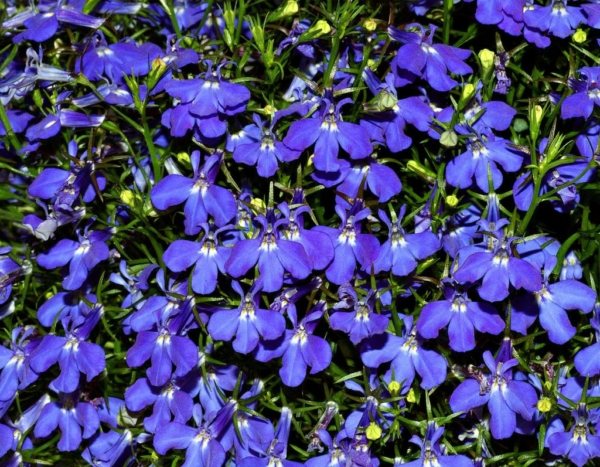

"White cascade"
The plant is remarkable in that it has long thin shoots, which are completely dotted with flowers of snow-white color. Such a plant looks unusually gentle and elegant. Light and water-loving, capable of pleasing the eye before the onset of frost.


"Red cascade"
According to the characteristics of cold resistance and abundance of watering, the variety is similar to the previous one. Differs in that blooms in all shades of red, and very splendid.


When to sow lobelia seeds for seedlings
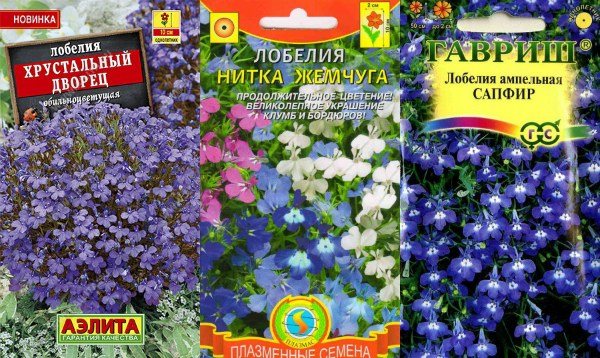

In this matter, it is worth starting from when you want to see the first flowers.
- For lobelia to bloom in June, seeds should be sown in March.
- If you sow in April, expect the first flowers in July.
- If you are the owner of a heated greenhouse, you can start sowing seeds already in January-February. In this case, already with the first rays of the warm sun, you can plant seedlings in open ground.
First of all, you need to focus on the climatic conditions of the region in which you live. The earlier you have spring weather, the sooner you can start planting.
Sowing dates, taking into account the regions and the lunar calendar
Planting lobelia in a flower bed, or taking out pots of flowers outside, is possible only when the weather is warm and there is no threat of night frosts.
For this reason, the timing of sowing seeds for seedlings will depend on the climatic conditions of the region in which you live.
As a rule, in the southern regions of the country, they start sowing seeds in February-March, in Siberia and in the Urals from the end of March.
Lobelia seedlings can be planted according to the lunar calendar.
In accordance with the lunar calendar, the following days are considered the most favorable for sowing lobelia seeds in 2019:
- January - 17-19, 23-27
- February - 6-8, 11-17, 21-25
- March - 12-17.19.20
- April - 6-8, 11-13, 15-17, 29.30
But there are also days when you should refrain from planting seeds:
- January - 5, 6, 21;
- February - 4, 5, 19;
- March - 6, 7, 21;
- April - 5, 19;
The dates indicated will help you not to make a mistake when choosing the day of planting the seeds of this beautiful flower.
Sowing lobelia by region
A decision is made to start sowing, taking into account the climatic conditions of the region. In the south of the country, seeds are planted in February, and even January, to decorate flower beds and decorate the borders of garden paths before the onset of heat.
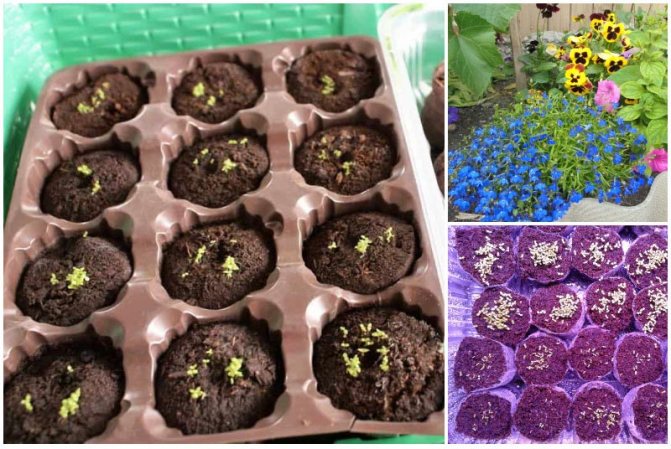

When sowing lobelia seeds, they take into account not only the climate of the region, but also the peculiarities of the weather.
| Region | March | April | May |
| Krasnodar region | + 4 ... + 9 ° C | + 9 ... + 16 ° C | + 15 ... + 22 ° C |
| Karelia | -5 ... -2 ° C | + 1 ... + 5 ° C | + 7 ... + 13 ° C |
| central Russia | -8 ... 0 ° C | + 1 ... + 10 ° C | + 8 ... + 19 ° C |
| Siberia | -8 ... -3 ° C | + 2 ... + 8 ° C | + 7 ... + 14 ° C |
| Yakutia | -19 ... -14 ° C | -6 ... -2 ° C | + 4 ... + 11 ° C |
| Far East | -4 ... -9 ° C | + 1 ... + 8 ° C | + 8 ... + 16 ° C |
In the south of Russia, starting from February, you can start sowing seeds. Territories to the north are postponed until March. Residents of Siberia and the Urals begin work at the end of March. When the threat of night frosts has passed, you can relocate lobelia seedlings to clubs, and take flowers in pots outside.
Growing lobelia from seeds at home
For the cultivation of annual lobelia, the seedling planting method is used. When multiplying crops, planting and care will be successful only if the nutrient soil is properly prepared and the correct method of sowing seeds is chosen.
You need to know that lobelia seeds are planted on moist and slightly compacted soil.
The choice of soil mixture
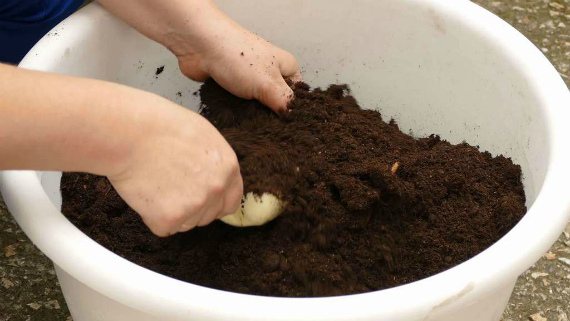

You can sow lobelia seeds in a ready-made potting soil mixture, or you can prepare it yourself. For this you will need:
- two pieces of garden land;
- two parts of well-ripened peat;
- two parts of humus;
- one part of dry sand;
Lobelia loves alkaline, loose soil, since the thin stems of seedlings are prone to lodging. Before sowing seeds, it is necessary to treat the soil with a fungicide in order to prevent the development of various fungal diseases.
Sowing methods
Knowing the little tricks of sowing lobelia seeds for seedlings can help you grow beautiful and healthy plants.
With sand
In order for small lobelia seeds to be evenly distributed on the ground, they are pre-mixed with dry river sand. Then this mixture is sifted over the surface of the soil.
Sowing lobelia seeds with sand - video
Using a toothpick
For this method, take a toothpick, moisten its tip in water, and immerse it in the seeds. Small seeds will stick to the toothpick and can then be easily spread over the entire surface of the soil.
Into the snow
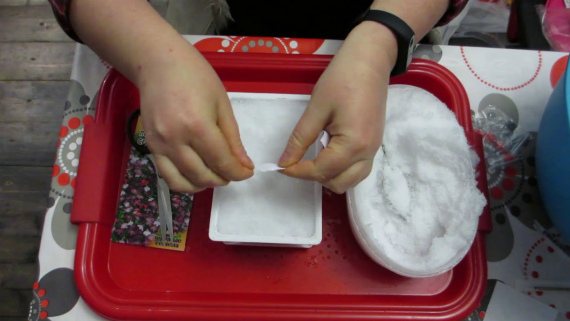

A thin layer of snow is placed on top of a container with earth, and lobelia seeds are scattered on it. In white snow, dark seeds will be clearly visible, and this will help to distribute them correctly over the entire surface.
With hydrogen peroxide
For this method, take seeds, pour them into an empty glass and pour a small amount of peroxide. Leave for 5-10 minutes. Next, a little water is added to the soaked seeds and with the help of a teaspoon the whole mixture is evenly distributed over the surface of the earth.
In peat tablets
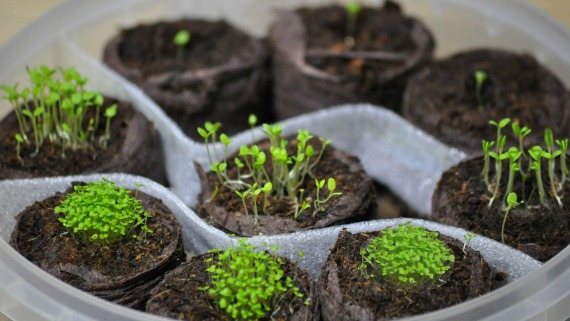

Ideal for planting seeds. Peat tablets must be poured with hot water (for 10 minutes), and when they swell, seeds can be planted. In the future, when the seedlings grow up, they can not be thinned out, but also transplanted into a flower bed or pot.
In tea bags


Cut off the thread and the place of gluing from tea bags, and straighten the bag well. You should not throw away the tea leaves, it will serve as fertilizer and drainage. A little earth is poured on top of the tea leaves, and all filled bags are folded into a plastic container. The ground in bags is watered and spread out one seed at a time.
Characteristics of ampelous lobelia
Lobelia ampelous was brought to Russia from Central America, where it is a perennial plant, but due to the severity of our winters, it is cultivated as an annual plant. The definition of ampelous indicates that its stem is not able to stand on its own, but requires a supporting structure or is intended to hang from a flowerpot or pots. Such plants are used mainly for decorating a personal plot, garden paths, as a flower border of a lawn, or for decorating the walls of a gazebo, veranda, garden houses, where plants are hung in pots.


They differ in brightness and variety of colors. In addition, they form very lush small spherical bushes that look great. But these plants require a lot of attention, love and patience.
If you set yourself the goal of growing lobelia on your site, then in order to achieve positive results in the first year, it is advisable to invite or hire, if funds permit, a knowledgeable person who would teach you in the cultivation of lobelia and caring for it.
Reading books and magazines on floriculture is very good in itself, but a living step-by-step guide in the difficult business of cultivating this finicky plant is difficult to overestimate.
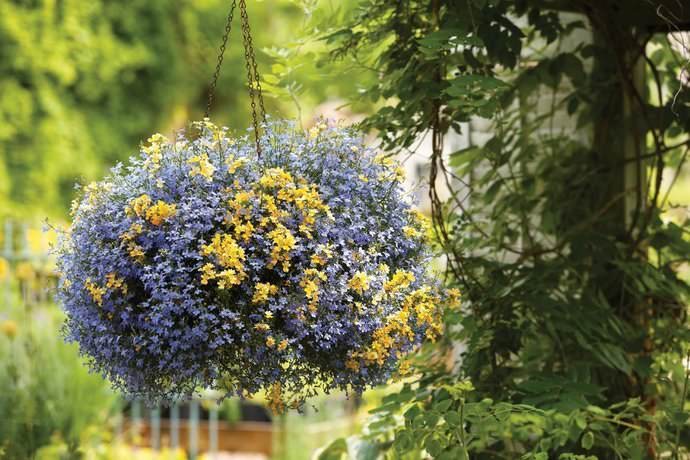

Lobelia seedling care


The care of lobelia seedlings has its own nuances that affect the development of the plant and further flowering. The first shoots of lobelia begin to appear 5-10 days after sowing the seeds, and they need careful care.
Watering
Lobelia seedlings tolerate drought and bay equally poorly.
- The top layer of the earth should not be allowed to dry out strongly (we are talking about 1-2 month old seedlings, adult plants are more hardy).
- It is also impossible to flood the plant too much, otherwise it will get sick and die. It is necessary to ensure that there is no excess water in the pan.
Lighting
In order for the seedlings to grow well, they need to provide a long daylight hours (at least 12-14 hours). It should be borne in mind that direct sunlight can harm the plant.
Therefore, provide the seedlings with diffused light or oblique sunlight, combined with good watering.
From the bright daytime sun, seedlings can be covered with paper or a light cloth.
With a lack of sunlight, fluorescent or other fluorescent lamps are used.
Top dressing
At the age of one month, seedlings are fed with universal fertilizers. It should be borne in mind that the concentration of such fertilizers should be 2-3 times weaker than recommended for an adult plant.
Picking


They begin to dive seedlings when two or three real leaves appear on it. It is necessary to make a dive in bundles of 5-10 sprouts, while not crushing the earth, but replanting it together with a lump of earth. It is very convenient to use a teaspoon or a small spatula as a tool.
Pinching
When the seedlings grow to 5-7 cm in height, and they already have 5-6 true leaves, you can pinch the tops of the plants. This manipulation will help the plants grow more lush and also provide abundant flowering.
Hardening
1-2 weeks before planting seedlings in open ground, the plants are hardened. As soon as the air temperature outside rises to 10-15 ° C, you can take out the seedlings to the balcony for 5-10 minutes. Gradually, the time spent in the fresh air is increased, and then they are left for the whole day, and all night (provided that the frost has already ended).
How to germinate seedlings
After sowing the seeds, the container is covered with a transparent film and removed to a bright place. The temperature should be at least +18 degrees. The film must be removed daily so that the seedlings are ventilated and breathed.
The first shoots will appear 10-15 days after planting. When sprouts appear, the film is removed and they begin to monitor the moisture level of the soil with redoubled attention. If the soil is allowed to dry out, all seedlings can quickly die. It is better not to water the soil itself, but to provide moisturizing of tender sprouts by pouring water into the pan.
Attention: at first, lobelia seedlings grow extremely slowly, but the more time passes, the faster and more actively they begin to develop.
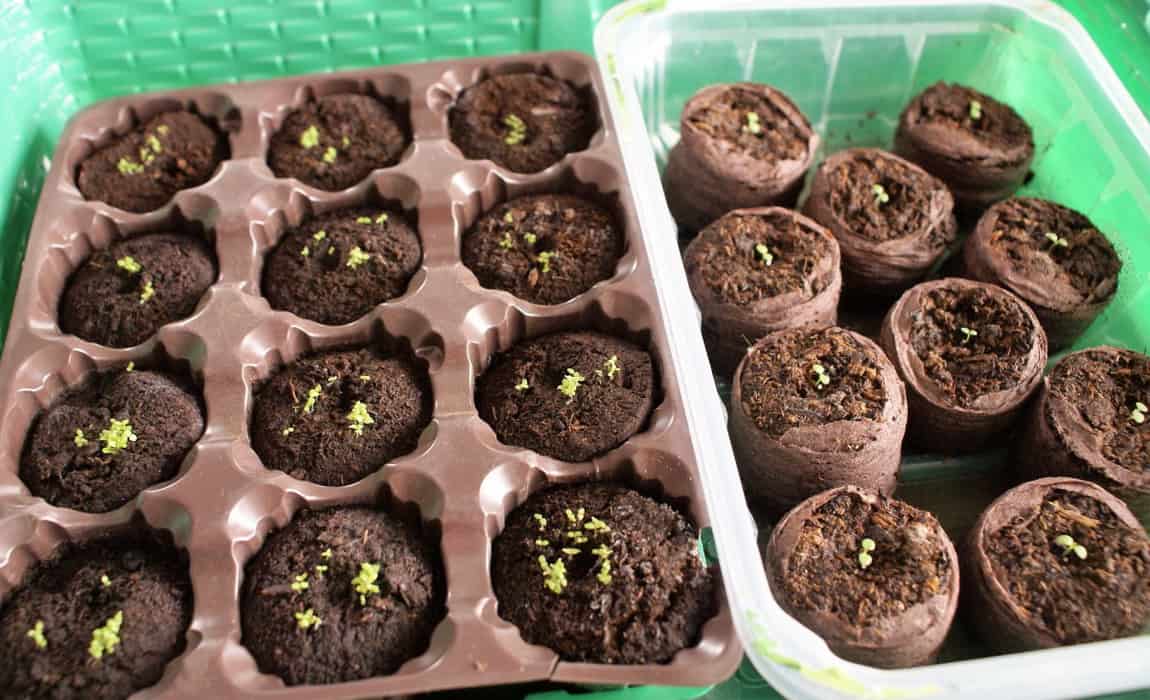

When the seedlings reach 3-4 cm, they are dived in separate containers. No more than four sprouts are usually placed in one container. Since there are usually a lot of seedlings, the strongest and strongest plants are chosen.
In containers where sprouts dive, drainage holes must be provided. This measure will eliminate stagnant water and root rot.
And when the seedlings reach 7 cm in height, the top of each sprout must be pinched. This measure provides the future adult lobelia bush with wide branching and splendor.
Transplanting seedlings into open ground
When the weather is warm and the night frosts are over, lobelia seedlings are planted in a permanent place of growth.
As a rule, planting of plants begins at the end of May and continues until mid-June.
- Seedlings are planted in small bushes (5-10 stems each).
- When planting, it is necessary to leave a distance of 15-25 cm between the bushes. Each bush will require about one kilogram of land.
Since lobelia loves bright, but diffused lighting, it must be planted in partial shade. A small amount of direct morning or evening sunlight is permissible; the plant must be shaded from the hot midday sun.
Landing features
When starting to plant ampelous lobelia, it is useful to know what features this type of plant has. This also applies to the exactingness and type of soil, and other nuances.
How to choose and prepare the soil?
Lobelia grows well in moist soil with neutral acidity, providing high breathability. Similar compositions are widely available in specialized stores. But if you wish, you can make a suitable soil on your own, it is not too troublesome.
You will need to mix in equal proportions turf, peat, humus and add half a portion of the coarse river sand. Special peat tablets are also suitable for seedlings. in the future, they can be moved to a permanent place along with the sprouted seedlings.
The selected soil requires preparation to obtain good germination. It must be treated with a highly diluted solution of a fungicidal agent, heated over steam, or simply spilled with boiling water. The soil disinfected in this way must be dried.
Sowing seeds in a small container
This is one of the main planting methods favored by flower growers. Seeds are sown in a small container or pot and transplanted into a larger container as they grow.
Advantages and disadvantages
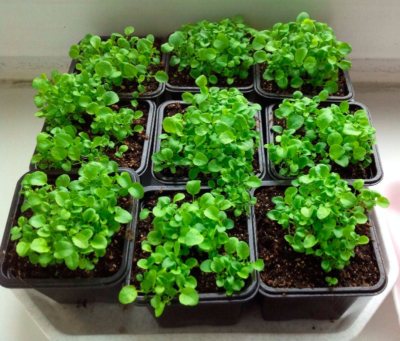

Benefits:
- it is more convenient to work with small volumes;
- after transplanting to a permanent place, the seedlings grow more actively.
Disadvantages:
- as the seedlings grow, a pick will be needed, and this is a very painstaking task;
- grown plants require transplanting into a permanent pot or box.
Step-by-step instructions for disembarking in a separate container
- Prepare soil and containers - pots, cups or peat tablets.
- Mix the seeds with a little sand and sow in small portions into the chosen containers.
- It is not necessary to deepen the seeds.
- From the moment of planting to the appearance of the first shoots, you need to keep the cups under the film.
- Requires daily airing for half an hour, otherwise mold may appear, which risks ruining delicate seedlings.
- Watering is done as accurately as possible, it is better to pour water into the sump or use a spray.
- The sprouts will appear within 1.5-2 weeks.
Sowing directly into a large container
You can sow seeds directly into a box or pots, which will become the permanent habitat of ampelous lobelia. The main advantage is to save time for the grower for the subsequent picking and planting of seedlings.
You also do not have to look for a large number of small containers for planting. It is also much more convenient to cover larger containers with foil. The downside is that the appeared seedlings may require thinning in the event that the seeds give very friendly shoots and they will not have enough space in the chosen planter.
Step-by-step instruction
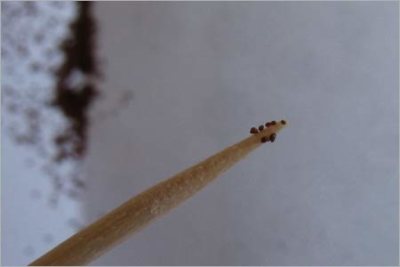

- Place the pretreated soil in the selected container for planting.
- Sow seeds on the surface of the soil, or use an alternative method. For him, you need to moisten a scrubber or a match, dip it into the seeds, and then place it shallowly in the ground.
- You can also mix the seed with the soil and simply spread it evenly over the ground for planting.
- Subsequent care for the seedlings is carried out in the same way - place under a film, ventilate, water.
What colors can be combined with lobelia
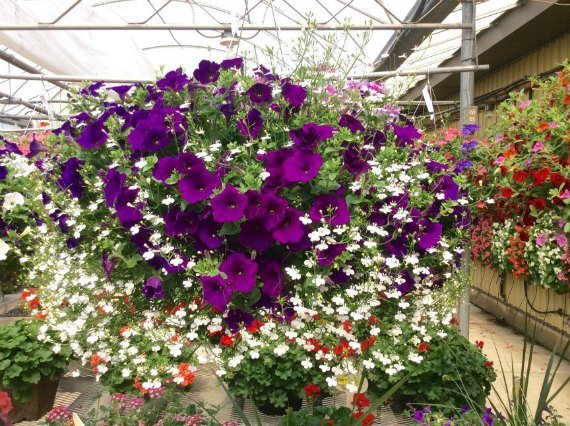

Since lobelia, with its shoots, forms small clumps that resemble pillows decorated with blue and blue flowers, the following plants will be a wonderful company:
- Alyssum, verbena, bell, carnation, salvia.
- To create compositions in hanging pots, ampelous petunia and graceful white or purple lobelia are often used.
- It is also a good idea to plant begonias, pelargonias and balsams nearby, with red or pink flowers.


Nearby, low-growing varieties of lemon or yellow marigolds look great.


Types of lobelia with creeping stems can be used as a ground cover, and if the shoots are long and hanging, then the flower can be planted in a pots as an ampelous plant. In this case, it is better to plant chlorophytum or asparagus next to it.
Popular varieties
Ampel lobelia refers to the species of annual plants. Stems are long, during growth they can reach 35-40 centimeters. Leaves are light green in color, but in their development they can acquire a lilac hue.The variety is distinguished by abundant flowering: the flowers are single, located at the tops of the shoots, frequent. The color scheme of ampelous lobelia is varied and highlighted by the following varieties:
- [li] Reggata Blue Splash(regatta blue splash) - white and blue petals;
- Reggata marine blue (Marina blue regatta) - deep blue petals;
- Reggata lilac (regatta lilak) - lilac petals;
- Reggata lilac splash (regatta lilak splash) - lilac-white petals;
- Reggata mix (regatta mix) - different colors of flowers;
- Reggata rose (regatta rose) - pink petals with a cream eye;
- Reggata sky blue (sky blue regatta) - solid blue petals;
- Reggata midnight blue (midnight blue regatta) - purple petals with a blue tint;
- Reggata white (regatta white) - white petals;
- Reggata blue white eye (regatta blue white eye) - blue color of petals with a small white eye;
- Sapphire (sapphire) - bright blue petals with a white eye.
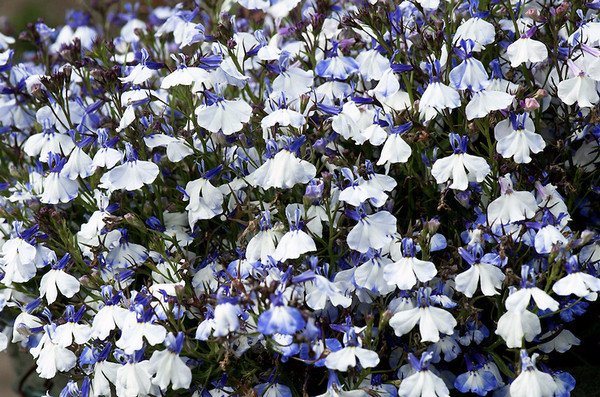







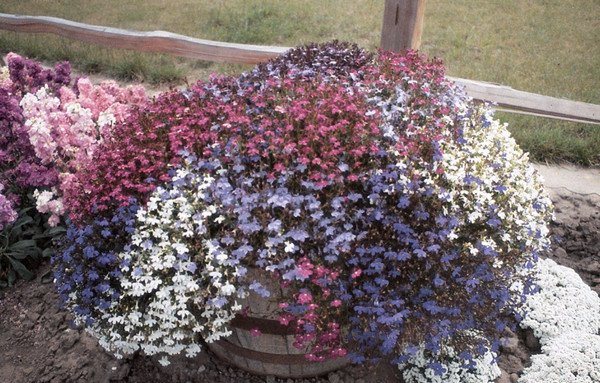

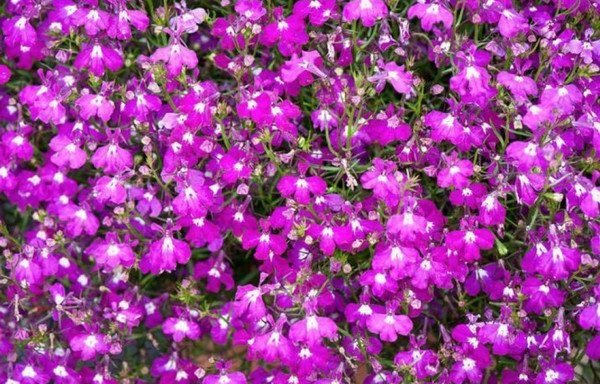



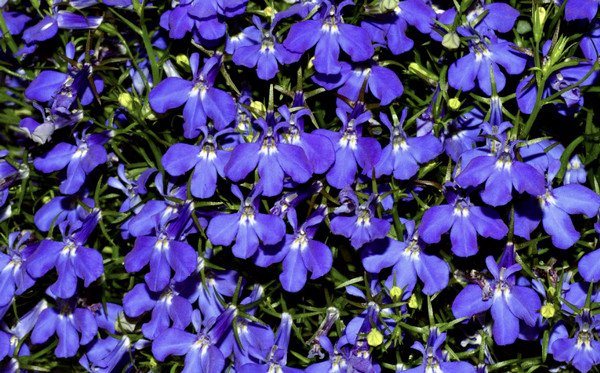

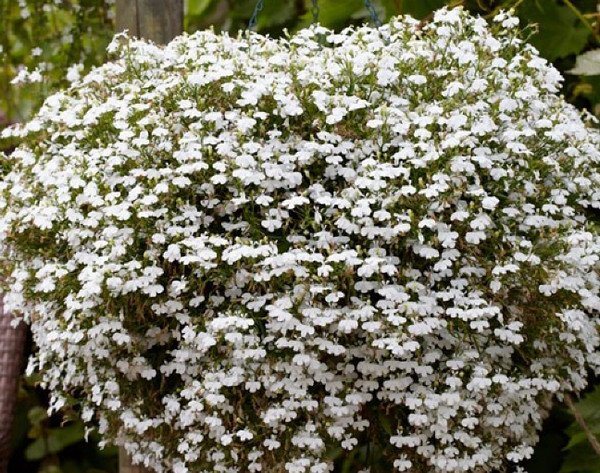



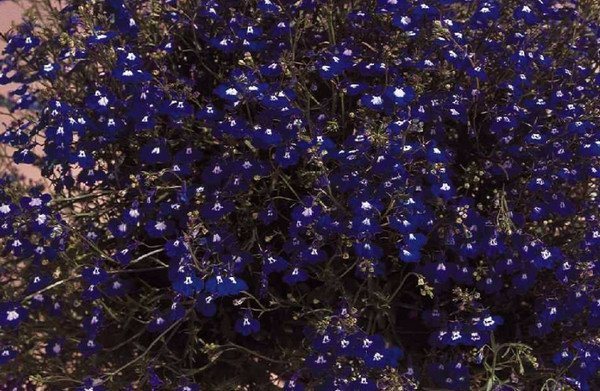

Of all the variety of lobelia flowers, the ampelous variety "Sapphire" is most in demand for sowing (and subsequent care).
Important! Lobelia flowers are never red and shades of red.
As you can see, the flowers of a fairly wide palette of colors and, in terms of their characteristics, are able to satisfy the tastes of even the most demanding flower growers.
Lobelia care after landing in a permanent place
Lobelia requires proper and constant care, knowledge of all the nuances will protect you from many problems and failures associated with growing this beautiful flower.
Watering and feeding


Since lobelia is considered a moisture-loving flower, it must be watered at least twice a day in hot weather. The top of the ground must be constantly moist.
Drought for lobelia is the sure death of a plant. In hot weather, the leaves of a flower in the sun dry out very quickly, the stems turn yellow and wither.
Also, lobelia does not like stagnant water near the roots. Therefore, when you plant it in a pot, be sure to take care of the presence of drainage at the bottom and drainage holes.
If there is a lot of organic or mineral fertilizers in the soil, the lobelia stops blooming well. Therefore, during the flowering period, the plant needs fertilizing with a minimum amount of nitrogen. It is better to fertilize the plant with potassium sulfate, then there will be so many flowers that the greens will not be visible.
Top dressing is applied 2 times per season:
- before flowering. Dry potash fertilizers are applied during loosening, then the earth is watered abundantly;
- during the flowering period. A complex mineral fertilizer is applied in dry form, also during loosening, or in liquid form directly under the root.
Pruning lobelia for lush bloom
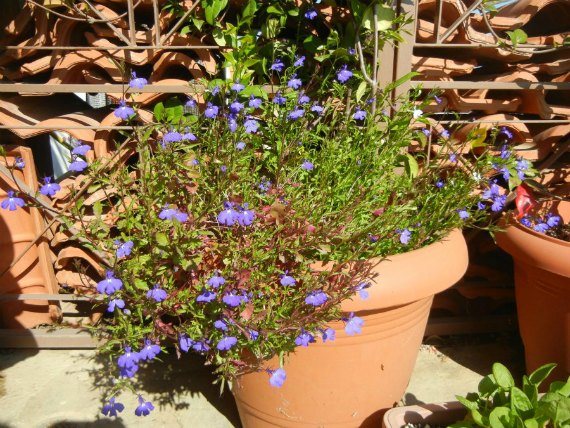

During the summer heat, yellowed and dry leaves appear on the plants, which must be plucked or cut off.
Directly in the middle of summer, a period of weakening of the flowering of the plant begins. Lobelia stalks are strongly elongated and turn yellow, flowers appear very rarely. The problem can be solved by completely cutting the bushes.
After such a radical pruning, the second wave of flowering will begin. When pruning the plant, it is necessary to leave about 5-10 cm above the ground, and soon the bushes will become overgrown with lush greenery, and after about 14 days they will bloom again.
Where is the best place to grow lobelia?
Lobelia ampelous will feel great in any place of planting, whether it is a pots, vertical beds, pots or direct planting in the ground. It is important to provide her with the main conditions for life:
- warm climate;
- Fresh air;
- well-lit (sunny) area;
- moderate watering at the root.
At home, plants such as petunia, sweet peas, verbena, marigolds, ampelous dichondra, levkoy, heather, pelargonium, dahlias, hippeastrum will feel good.
Diseases and pests
Thrips
If light spots appear on the leaves of flowers, then the plant is affected by pests - thrips. And the spots themselves are the place where they feed. The leaves gradually change their shape, and the flowers fade much earlier than on healthy plants. Thrips can be defeated with insecticides.
Gray rot
When plants get sick with this disease, the stems and leaves turn brown.And in conditions of high humidity, dusty plaque is also added. To protect lobelia from gray mold, it is necessary to normalize watering and remove all affected plants. In case of a strong development of the disease, it is necessary to apply a fungicide.
Blackleg
Most often, growing seedlings are affected by this particular disease. The root neck of the sprouts becomes darker and thinner. This, in turn, leads to lodging of plants and very early death.
If you notice such a problem in time, you can save the plants by treating them with special preparations. Some time after processing the seedlings, in the container where it grows, it is necessary to add a little peat or sand in order to provoke the germination of new roots.
Tracheomycotic wilting
This disease can affect both seedlings and already adult plants. Yellowness appears on the lower leaves, and they begin to wilt. Upon closer examination of the cut of the stems, you can notice the darkening of the vessels of the flower. Not receiving the necessary nutrients, the lobelia bush gradually dries up.
Treatments for tracheomycotic wilting are the same as for blackleg. Well, diseased plants must be removed along with a lump of earth, and the pits that form should be sprinkled with chalk or lime.
Variety of lobelia
Among the species of this plant known in our region, we will single out those that will grow well in your personal plot. These are representatives:
- Perennial, lobelia erinus. They reach a height of up to 125 centimeters, bloom in the form of spike-shaped inflorescences.
- Purple, cardinal lobelia. Suitable for large-scale plantings, as they grow in groups. They grow well in shallow reservoirs or swamps, therefore they are usually planted on the shores of artificial reservoirs.
- Dortman, bloated lobelia. This species is endangered. They usually grow in sandy coastal areas. They have especially beautiful blue and white flowers.
- Climbing, hybrid lobelia.
And also varieties:
- Ampelnaya;
- Ampel Sapphire;
- White Lady;
- Swallow's Nest;
- Lobelia Crystal Palace;
- and few others.
Sowing dates
Seed planting time
Lobelia begins to bloom only 70-80 days after planting the seeds. There is only one way to approximate the time for the appearance of pretty flowers on the bushes - to start growing seedlings as early as possible. To enjoy the flowering of lobelia from the very beginning of summer, you need to plant seeds in late February or early March. Some growers practice planting even in December or January.
Soil preparation
To grow lobelia seedlings, you can use a ready-made substrate for flowers or prepare a mixture of soil, peat and sand. A suitable soil can also be obtained by mixing soil and vermiculite. The prepared substrate is placed in a shallow tray with drainage holes and disinfected by treating with a fungicidal solution, warming up in an oven or pouring boiling water. The day before planting the seeds, the soil is well moistened and tamped a little. Lobelia seeds are conveniently planted in peat tablets.
Sowing lobelia seeds
Since lobelia seeds are very small, planting can be difficult. In order for the sprouts not to sprout too densely, which will greatly complicate thinning, one of the following methods is used to sow the seeds: • mix them with sand and evenly scatter them; • place the seeds on a folded sheet of paper and spread them over the surface of the soil by slightly tapping the sheet; • lower in a bag of seeds with a wet wooden toothpick and place the stuck seeds on the soil.
It is not recommended to sprinkle the seeds on top, as they germinate only in good light. The container must be covered with plastic or glass and placed in soft sunlight.
Gentle care
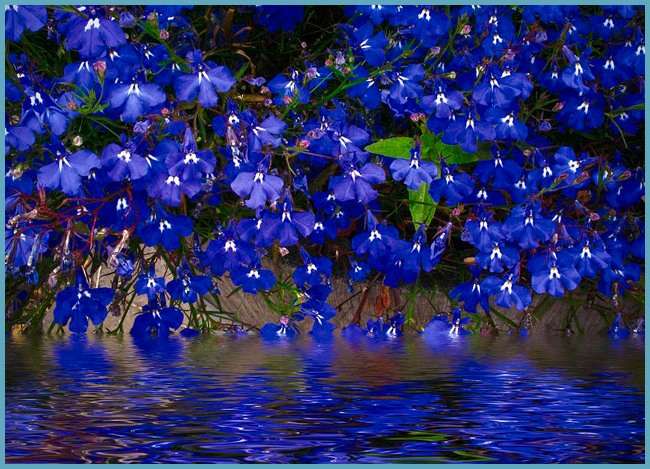

Watering mode
Pick rules
We will find out when and how to sow lobelia seeds for seedlings correctly.
When to sow
Lobelia from seeds germinates rather slowly, therefore, sowing should be carried out with a margin of time: the second or third decade of February is optimal. However, since the climate in the regions varies greatly, it is recommended to adhere to the following timelines:
- in the middle lane and in the Moscow region, sowing is best done on March 10-20;
- in the Urals and Siberia - from February 15 to the end of this month;
- in the south, in the Volga region, the Chernozem region - from February 10, you can already start sowing.
To get flowering lobelia bushes in early summer, it is necessary to sow its seeds when there is still snow outside. Keep in mind that the plant begins to bloom 8-10 weeks after the seeds enter the ground. Later in April, there is no longer any sense in sowing seeds: the flowering period in this case will be shortened, compressed.
What kind of soil is needed
You can use a flower substrate sold in garden stores. In addition, you can prepare the soil mixture at home and on your own. To do this, you need to mix the following components:
- sifted garden land;
- humus;
- fertilizer Agricola-7 - 1 tbsp. the spoon;
- nitroammofosk - according to the instructions.
Make sure that the soil is loose and permeable - this fact is very important for miniature lobelia seeds. In terms of acidity, the substrate should be neutral. If you prepare the soil mixture yourself, then in the case of acidified sod land, add dolomite flour.
Germinating lobelia seeds in the following mixture also yields good results:
- humus;
- vermiculite;
- sand.
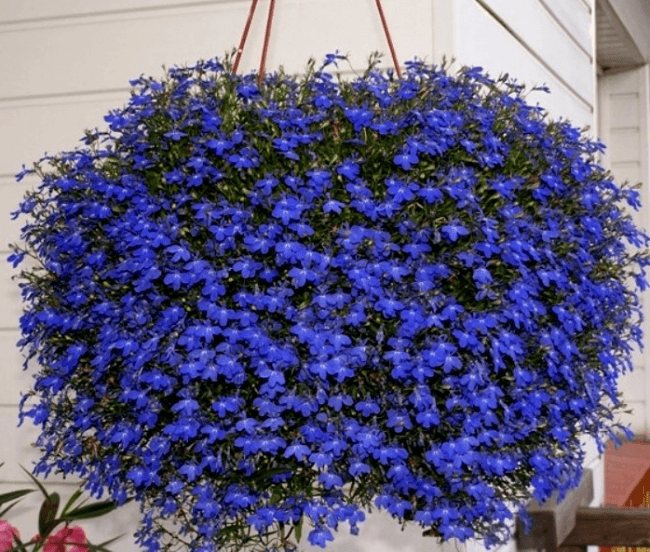

Humus can be replaced with horse garden soil, which is also quite nutritious in composition.
Important: if the soil is being prepared on its own, do not forget to scald it with boiling water to destroy harmful microorganisms.
After the seeds have hatched, the seedlings must be carefully looked after. Consider the main points of this departure.
Temperature
Lobelia seedlings must be grown at a fairly cool temperature: 13-17 degrees is the best option. The requirement is related to the fact that the seedlings must be prepared in advance for further planting in open ground.
Lighting, backlight
When the seeds had not yet sprouted, they did not need lighting. But after the emergence of shoots, the light of the lobelia is necessary. Since there is little light in our climate in winter and early spring, the seedlings are artificially illuminated. If the backlight is not provided, the seedlings will begin to stretch towards the window: as a result, the plant will bend.
Attention: when planting seeds in March and keeping seedlings on the south window, you can do without artificial lighting.
There are enough problems with moistening lobelia seedlings. The fact is that the seedlings of the plant are so frail and weak that even small drops of water falling from above can nail them to the ground. If watered by spraying, the seedlings may not rise afterwards. Therefore, watering must be carried out in such a way as to avoid water ingress on the greens. In addition to the danger of lodging seedlings, this will also save them from the Black Leg - a putrefactive disease.
In order to be able to water the seedlings normally, the seeds should initially be planted not with a solid carpet, but with separate bushes: in this case, free space remains. It is recommended to make small depressions in these free areas, where to pour water. Thus, the earth will be moistened, and the plants will not suffer.
Some growers water lobelia shoots from a syringe, aiming water at the walls of the container. The method works, but only if the capacity is small. Otherwise, the center of the container will remain dry.
Thus (in the grooves, from the syringe), you need to water the first 2-3 weeks after germination. Then the plants will get stronger and it will be possible to switch to spraying, and then to standard watering.
Important: the water should be warm and settled, without heavy impurities.
Picking
At first, seedlings grow slowly, but after reaching four centimeters, their growth accelerates. And during this period, picking of young plants is carried out. The strongest and most viable sprouts are selected and transplanted from the general container into an individual container.
A dive can be done with tweezers. But, unlike most other plants, lobelia is dived not by individual seedlings, but immediately by groups of these seedlings. Therefore, it is more convenient to use a small spatula or even a teaspoon. With this device, a bunch of seedlings is lifted together with an earthen lump and transferred to a separate container.
Immediately after picking, plants in new containers should be watered and then moved to a shaded place. When they take root, move the containers to the light.
Topping
The procedure is carried out after the seedlings take root after the pick and grow a little. Pinching is aimed at the development of branching, bushiness of the plant, its volume and splendor. In the process of pinching, the top of the head is cut off at each seedling - you can also use simple scissors on the principle of cutting the lawn.
Pinching in several stages makes it possible to grow quite lush, branchy bushes even from one shoot.
Lobelia usually begins to bloom while it is still sitting in a temporary container. It is transplanted to the street when the threat of recurrent frosts has passed: such shakes will not benefit a thermophilic plant. For most regions, planting in open ground of lobelia is recommended in the second half of May, earlier in the south.
Choose a bright and well-warmed place for the plant. As for the soil, lobelia will best show its decorative qualities in loam and sandy loam soils. It is necessary to plant bushes every 10-15 cm from each other.
We will find out what further care is needed for lobelia after transplanting it into separate containers.
Lobelia loves moisture very much: therefore, in order to grow it, it will have to be watered quite often and abundantly. The soil in the garden should always be slightly moistened. If it's hot, you can water it twice a day; in normal weather, once is enough.
Top dressing
When flowering is just beginning, treat the lobelia with potash fertilizers. And then add complex minerals for flowering plants two more times during the growing season.
Lobelia soil needs light so loosening after watering is necessary. At the same time, remove weeds. As for mulching, you can mulch the soil with a hydrogel when growing in pots, which will help the soil retain moisture longer.
Diseases and pests
In general, lobelia is quite resistant to diseases caused by parasites. If you plant it correctly and follow the conditions of care, it is unlikely that the plant will hurt.
When grown in the shade, waterlogging, the following diseases are possible:
- rust;
- root rot;
- spotting;
- powdery mildew.
These are fungal and putrefactive diseases, against which modern fungicides help. Root rot is most dangerous, as it can lead to the death of the entire plant.
They can be harvested by hand, trapped or sprayed with insecticides.


We learned how to grow lobelia from seeds. The plant is rarely grown as a perennial - our climate is not suitable for this. Therefore, every gardener who plans to plant lobelia on the site is obliged to know the procedure for sowing seeds and germinating them. But the main chores fall on the germination of seedlings: after planting in open ground, the flower needs much less attention.
The race for a certain variety can be started as early as December, but the seeds should be sown in late February - early March. If there is a phytolamp at home, then disembarkation begins in January. Otherwise, the sprouts will be elongated and weak.
Lobelia seeds are very small, like dust, so you can use the following simple methods to evenly distribute them over the surface of the soil:
- to plant "on the snow". Those. just bring a bucket of snow from the yard, put a layer of it on the ground and pour seeds from the pack onto it. At the same time, the seeds will undergo a so-called stratification;
- mix seeds with sand and sprinkle evenly;
- just buy granulated seeds.
But this is unprofitable: they are more expensive, and the number of seeds in a pack is much smaller, and there is also the possibility of an empty granule without a seed inside.
Watering and loosening
Pruning stems
In the middle of summer, lobelia begins to lose its strength. The stems turn yellow and stretch in length. In order to prevent such a phenomenon, it is necessary to prune the stems in a timely manner. After that, the plant begins to actively bloom again.
When carrying out this procedure, the stems are cut so that their length remains about 5-10 cm. The leaves begin to grow quickly, and flowering begins in 15 days. In order for the lobelia to bloom especially magnificently, it must be fed with potassium sulfate. At the same time, it is not recommended to introduce nitrogen fertilizers for this culture.
If you don't want to mess around with growing seedlings from seeds, you can plant perennial lobelia on the site. However, in cooler climates, the plant will need to be replanted every season.
Lobelia is usually grown to decorate paths in the garden, in parks. They are also planted along the edge of flower beds or on alpine hills. The plant looks very beautiful in trays on loggias or in hanging pots. Often, in garden plots, you can see lobelia growing next to garden flowers such as pelargonium, balsam, verbena, etc.
Watch the video! Everything about lobelia - from correct sowing to flowering !!!
The main problems and how to solve them
Lobelia is considered a strong, disease-resistant flower. But incorrectly performed procedures reduce the resistance of the culture. The most common growing problems are:
- Waterlogging. Not all lobelias can grow in humid environments. Watering should take place as needed (dry soil). Leads to the appearance of fungal diseases, black leg. Solution: remove diseased processes. Disinfect healthy ones together with the soil with biofungicides.
- Lobelias are often attacked by spider mites. Sucking insects try to get inside to absorb the juice. The green mass is withering away, withering away. Solution to the problem: increase the number of watering, carry out regular spraying with a solution of soap shavings. With a large lesion, insecticides are used.
- The appearance of fungal diseases at the initial stage occurs due to the lack of soil cultivation, capacity. In case of severe damage, all seed material will have to be replaced.
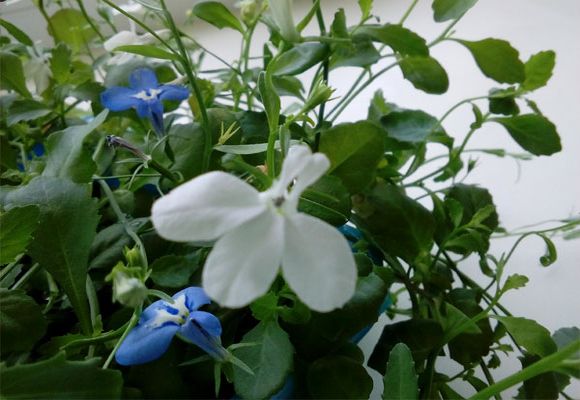

Florist reviews
Lvovna
Lobelia syphilitica Lobelia siphilitica is a perennial. I like. It is blooming profusely and for a long time. In addition to blue, there is also a white-flowered form
sova-uh
I sowed on a damp napkin, in a salad jar, and after the seeds hatched and released the cotyledons, I planted bunches in the ground. If you cannot remove it from the napkin, you can directly with it
How to keep lobelia safe in winter?
- For the winter, an adult lobelia can be taken home. In flower pots, she can stand all winter and will live until spring. Therefore, it is advisable to transplant the plant into pots, cut them right down to the bottom leaves and leave them indoors. It should be a bright, not hot, dry place.
- Under these conditions, lobelia will survive well in winter and will be adapted to a new transplant on open soil in the spring. If the plant has wintered, you need to wait until its bushes become stronger and the heat outside becomes stable. The most suitable time is the first days of June, at which time the plant can be taken out to the flower bed.
- It is better not to breed a young lobelia for the winter. A flower that has not matured will definitely die.It is much easier to remove adult flowers from the cold or plant a new one in spring.
- Growing lobelia at home is a worthy decoration of carpet compositions, an excellent design for home borders, flower beds and other areas. During cold weather, this is a gorgeous design of a balcony or window sill. It remains to include imagination!
Another way of sowing
You can sow lobelia seedlings in another, very popular way recently. Cultivation "in Moscow" at first saves space in the house and allows even capricious crops to germinate. This method is better known as germinating seeds on toilet paper. This will require seeds, polyethylene, a glass, water and the paper itself.
Table. Sprouting lobelia seeds in rolls.
| Steps, photo | Description of actions |
Step 1 | A strip of polyethylene (or a plastic bag) is taken, from which a strip about 10 cm wide is made. 2-3 layers of toilet paper are laid out on top of the polyethylene. |
Step 2 | Water from a syringe or spray bottle moistens all the paper. |
Step 3 | Lobelia seeds are spread on the surface of the paper at a distance of 2-4 cm. At the same time, only 1.5 cm recede from the edge of the strip. When laying out the seeds, it is convenient to use tweezers from the manicure set. |
Step 4 | Seeds placed in a row are covered with a strip of paper. |
Step 5 | The resulting workpiece is rolled into a neat roll, which is secured with a thin elastic band. At this stage, a tag with the name of the variety and the date of sowing is also glued to the film. |
Step 6 | 3-4 cm of water is poured into a plastic glass, a roll of seeds is placed there, the entire container is covered with a bag to keep warm. After the first shoots appear, the plants can be fed by adding a little fertilizer to the water. |
Step 7 | Young lobelias grown in this way are convenient for diving. As soon as the first leaves appear, the roll is rolled out, and the plants, along with a piece of paper, are cut off from the entire strip. Those seeds that have not yet sprouted can be wrapped back in cellophane and left in a glass. |
Step 8 | Sprouts are dived 1 piece together with paper into separate containers. |
Video - We plant lobelia seedlings
Lobelia pick
Picking seedlings plays a very important role, this is a jewelry work that many growers simply hate. How to dive lobelia? Various methods are used. But experts have found the most optimal way to dive seedlings. To do this, the sod is simply cut into pieces with a spoon or other tools, after which each of them is planted in its own separate pot, in which drainage is provided in advance.


If you chose peat tablets, then picking will be much easier. It can be carried out at least 1 month after the formation of full seedlings. It is recommended to do this in mid-May. By that time, the buds should have formed, and some of them will already bloom. When planting, mature plants are able to withstand temperature drops and a sharp change in habitat. But if the temperature is very low at night, it is better to use a protective material to cover the plant with it.
Choosing a container for growing
As for the choice of container for sowing lobelia, there are no fundamental points. You can pick up almost any landing container that suits you best.
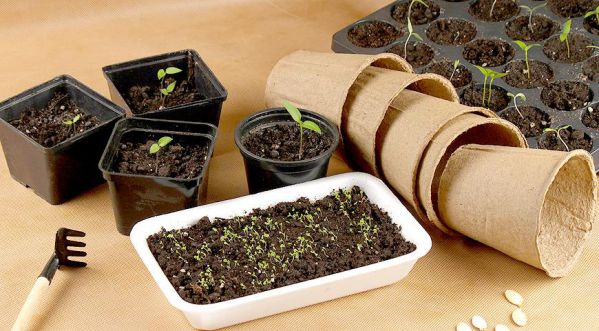

For example, you can use a plastic or wooden box, plastic or peat cups, plastic cassettes, peat tablets, various bowls, homemade containers. But it is best to choose a wide and shallow container for sowing.
Important! The landing containers must contain drainage holes (except for peat tablets and cups).
Picking
Because they will grow up (especially for cascading lobelia), and it will be very difficult to separate them from each other: when uncoupling several intertwined plants, it is quite easy to break thin stems.
You can start diving seedlings when three true leaves appear, the first two do not apply to them. The transplant is done with a fork. You just need to gently pry the seedling with a clod of earth and plant it in a pot.
Stick 6-7 pieces of seedlings into one pot, this will give the necessary density to the future plant.If the lobelia was planted in peat tablets, then the picking operation disappears.
Sowing seeds
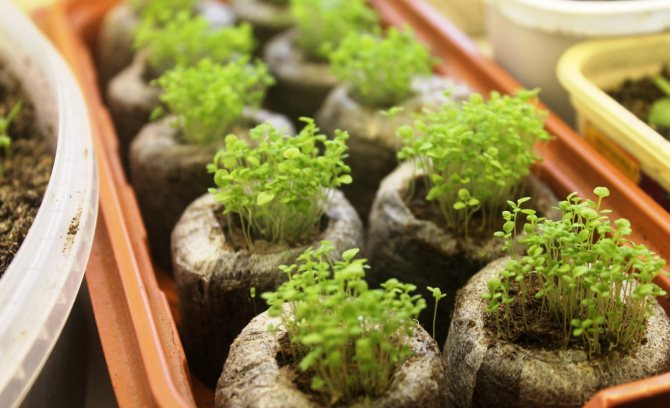

Now the main question is how to plant and how to sow the seeds of this plant with your own hands. If you look at the seeds, you will see how small they are. They rather resemble fine sand, rather than a future plant with lush flowering. Because of this, a lot of seeds can simply fall out of your hands if you try to plant them one at a time. It's almost impossible.
Someone uses tongs, toothpicks and other items for jewelry work. You can wet the end of a toothpick or match, “glue” some seeds, and place them in the prepared soil. Take fine river sand and mix it with the seeds. Sand must be disinfected beforehand. It is recommended to treat the seeds using fungicide powder. This is an additional protective measure. After that, follow a few guidelines:
- before sowing prepared soil, pour hot water into containers with soil;
- loosen the top layer of soil and pour seeds mixed with sand into it;
- further watering or backfilling of seeds from above with soil is not performed;
- close the plastic container and leave in a bright place where the sun is as long as possible every day;
- provide the container with a temperature within 20-22 degrees, but not more;
- check the temperature regime every day - violation of it will lead to death.
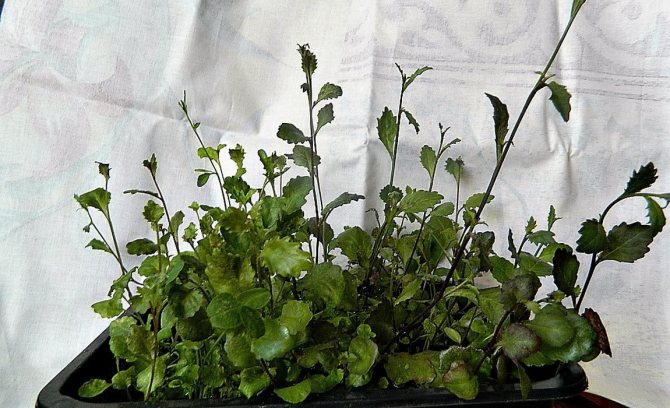

Necessary conditions for growth
With the appearance of small green shoots, the lobelia is transferred to a bright place. At the same time, the temperature regime, the frequency of watering, and the duration of daylight hours are observed. Artificial lighting is used.
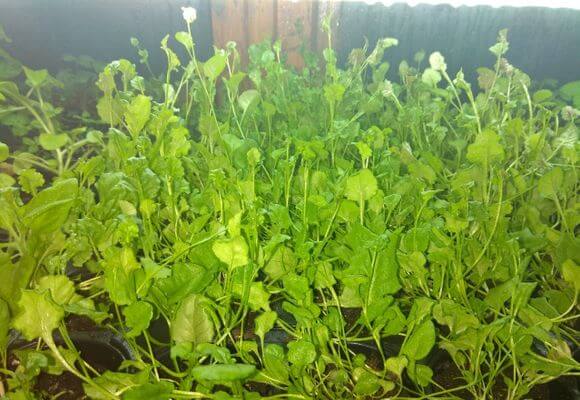

Lighting
Throughout the growth of seedlings, up to transplanting to a permanent place, lobelia needs a lot of light. Since sowing takes place from February to April, you will need to purchase a non-incandescent lamp.
Otherwise, the sprouts will burn and die. Duration of lighting maintenance: not less than 12 hours.
Humidity
Not all plant varieties like a lot of water and high humidity. It is necessary to clarify the variety, watering requirements. In order not to destroy the sprout, it is watered by drip, using a syringe. You can also add water as needed into the sump.
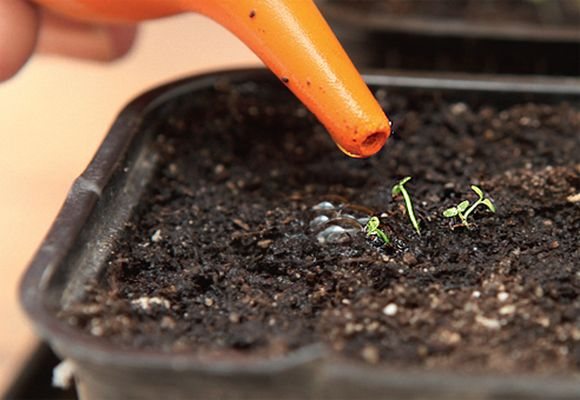

Temperature regime
The air temperature in the room where lobelia grows should not rise / fall at 18 degrees. Only after transplanting will the plant calmly tolerate temperature changes. It is imperative to carry out hardening, airing.
Top dressing
There is no need to feed the flower at the germination stage. All the necessary elements are already in the soil mixture.
Picking
A jewelry event that requires special attention. For the process of transferring a seedling, tweezers are required. As a last resort, a toothpick. The root system is not yet strong. Therefore, the seedling is transferred to separate containers together with the soil.
Lobelia containers must meet the above requirements: the presence of drainage holes on the walls and bottom.
The picking procedure can be carried out only after 28-30 days after the emergence of sprouts.
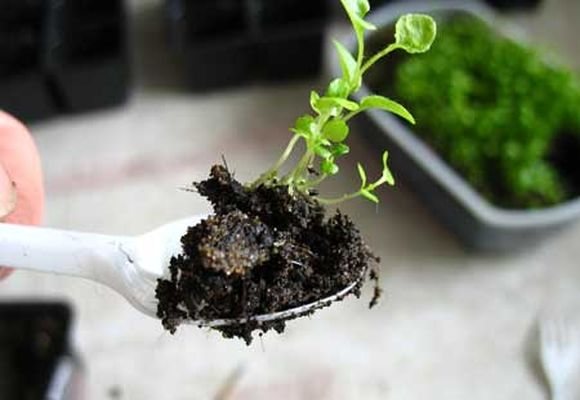

Pinching
The pinching procedure is necessary to create a neat lush bush. When the sprout reaches 4 cm, the upper part should be trimmed with scissors treated in a disinfectant. You can also pinch off with your fingers. Before this antiseptic, moisten your fingers, let them dry.
Hardening
Hardening of seedlings begins on the second day after planting. It looks like airing, removing condensate from the covering material. After the sprouts appear, the duration of these procedures increases gradually.
Removing the shelter is a signal for real hardening. Lobelia pots are taken out on the loggia only 2-3 weeks after the appearance of all the sprouts.Closer to the transplant, the hardening time should be 1-2 hours in the morning and the same in the evening.
How to care for planted seeds and seedlings?


Seedlings planted in the ground need special care. Namely:
- moderate watering;
- maintaining the required temperature;
- air circulation.
As for the required temperature, in the place where the boxes with seedlings are located, a temperature of at least twenty degrees is needed. It is also necessary to ventilate this room daily. Remove condensation from transparent glass or film in time.
This procedure is usually performed once a day. At a time when the seedlings are ventilated, you can water the soil. Watering is best done from a spray bottle. As soon as the early shoots appear, instead of a spray bottle, take a regular medical syringe for irrigation. So it is necessary that moisture does not get on the shoots, then the plant will grow healthy.
In order for lobelia to give strong shoots, it must be kept in a well-lit place. Therefore, if you plant a plant at the beginning of February, make sure that it has additional soft lighting. Seedlings need a pick when they are two or three weeks old.
Since the sprouts at this age do not yet grow enough, it will be more convenient to use tweezers or a small plastic spoon, grabbing several sprouts at the same time to plant them in one box.
Landing in the garden
The grown seedlings need to be planted in open ground or pots, for this, think over the placement of the bushes in the flowerbed in advance, taking into account the requirements set out below.
Dates of disembarkation in open ground
Adult individuals of the African guest tolerate slight frosts, but in spring they can destroy the seedlings pampered by the home climate. The transplant is carried out after the last night frosts recede. For the Middle Lane, the optimal time is mid-May, for regions with a more severe climate - early June.
On a note! Residents of the south of Russia can sow seeds directly into open ground in the third decade of April. If necessary, cover the flower bed with foil or agrofiber.
Site preparation, transplant technology
When choosing a site and replanting, follow these instructions:
- Choose an area with openwork penumbra. In the sun, the soil dries up faster, and bright flowers are prone to fading.
- Increased soil fertility will certainly affect flowering, and not for the better. An excess of nitrogen will cause the green mass to build up; there will be few flowers on such a specimen.
- The optimal soil for growing is sandy loam or loam. If the soil is too dense, sand is brought in, the soil is dug up. Additional enrichment with minerals and organics is not required.
- All crop varieties are prone to cross-pollination. When cultivating a population in order to obtain offspring, a distance between different varieties of at least 200 m should be observed.
- When growing ampel varieties in pots, take into account the peculiarity of this container. The confined space contributes to the rapid depletion of the soil, high humidity. Choose the right substrate, use a high drainage layer, apply fertilizers in a timely manner (once a month).
- Seedlings are transplanted in groups of 4-7 specimens. If you keep a step of 15 cm between them, you get a solid carpet. Plant at a distance of 25 cm for spherical curtains.
- After abundant watering, the seedlings are removed from the container with a scoop, placed in small holes. Around each bunch, the soil is carefully compacted, and abundant irrigation is carried out.
Advice! To protect the superficial roots from drying out, choose a planter of a light shade.
Reproduction of lobelia
Reproduction of lobelia: seed method and vegetative
Lobelia propagation by seeds
Lobelia is propagated by seeds, therefore, for further cultivation, they must be collected on time.
Lobelia seeds are very small and can crumble, so you need to monitor the condition of the flowers. When they have completely bloomed, the shoots are carefully tied together, and then the seeds are knocked off them onto white paper.
The collected lobelia seeds are stored in paper bags or containers.
Propagation of lobelia by cuttings
Propagation of lobelias by cuttings is not a difficult task. This will require an old bush dug up in the fall at the end of last season.
Cut the cuttings 5-7 cm in size to stimulate root growth, dip in "Kornevin" and stick into a wet mixture of vermiculite and sand (in a 1: 1 ratio).
Place the container with cuttings under a transparent bottle with a cut-off bottom, leave the lid. It turns out such a homemade greenhouse. Remove the cover periodically and air the cuttings. After a couple of weeks, they will start up young roots, and after a month and a half they can be planted in the ground.
Forum: testimonials and advice from florists
Experienced gardeners consider lobelia one of the most decorative flowers for decorating a flower bed, rabatka, mixborder. They go well with petunias, and perennial varieties will harmoniously fit on the shore of an artificial pond.
Some people practice the cultivation of seedlings in the shell of a chicken egg. To do this, it must be blown out, and the casing must be thoroughly rinsed and dried. A quarter of the shell is carefully removed to form a small pot. Experienced summer residents say that such a capacity will make the seedlings stronger by enriching the soil with calcium.
In order not to grow seedlings every year, summer residents dig up the most beautiful bush in the fall, provide it with a cool winter. In the spring, pruning is carried out to stimulate tillering, and the branches are rooted in perlite to create a new population. The beauty of this method is in the complete preservation of varietal characteristics.
Care problems


The only difficulty that could happen with a slobe is insufficient germination of shoots and a delay in flowering. These are the consequences of a lack of water or prolonged exposure of the plant for the whole day in hot sunlight. With proper care of the plant, no consequences arise.
Other problems associated with diseases and pests have not yet been noticed when growing this flower crop. Therefore, it is very easy to grow it, including germinating it, starting from seeds.




